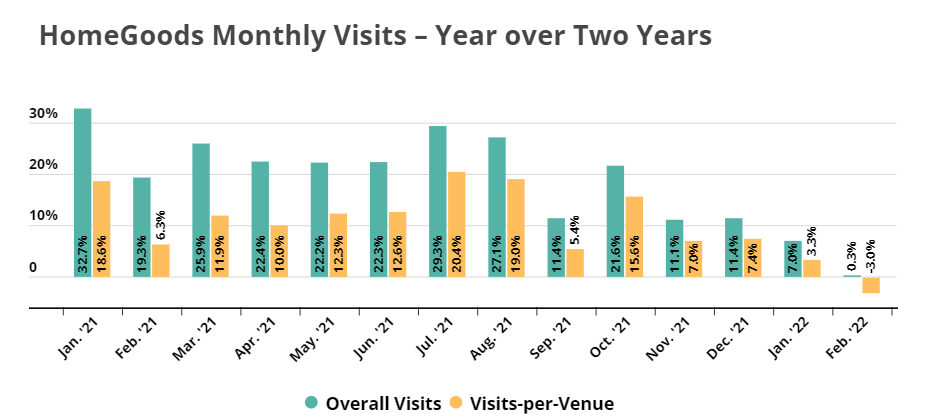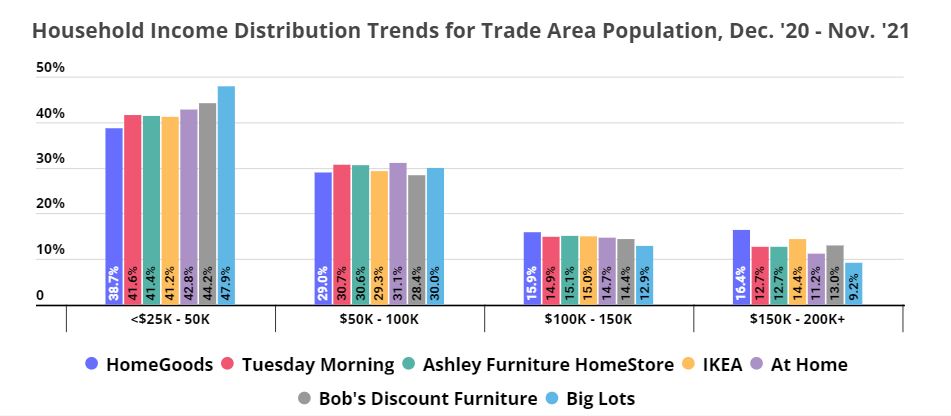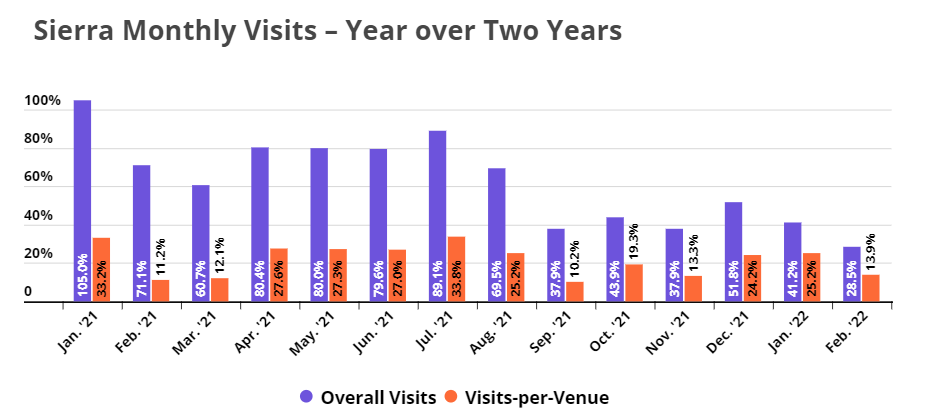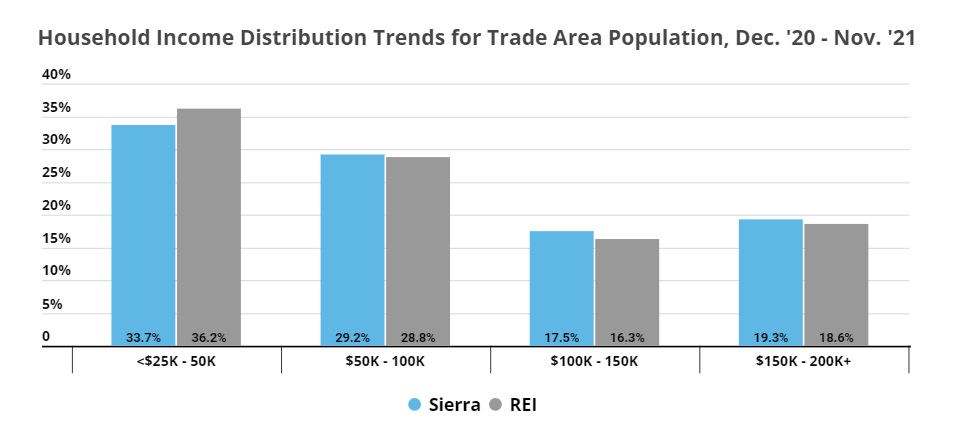
TJX, which operates off-price chains in categories ranging from apparel (T.J. Maxx and Marshalls) to recreation gear (Sierra) to home furnishings (HomeGoods), is a retail powerhouse. Foot traffic to the company’s portfolio brands was strong in 2021, and early 2022 data indicates that this year will be just as robust. We dove into foot traffic trends and consumer demographic information to better understand the secret to this heavy hitter’s success.
T.J. Maxx & Marshalls
The off-price sector has been over-performing the apparel average ever since stores opened back up in 2020, and T.J. Maxx and Marshalls are no exception. Year-over-two-years (Yo2Y) monthly visits to T.J. Maxx were up every month for the last three quarters of 2021; Marshalls also saw impressive visit surges over the summer and managed to keep its visit gaps extremely small in months where foot traffic didn’t quite reach growth.
Visits did fall in early 2022 – likely due to the rise of Omicron – but if 2021 foot traffic trends are any indication, both brands should see a visit increase again as soon as March.
T.J. Maxx and Marshalls Within the Wider Off-Price Sector
Two main elements set Marshalls and T.J. Maxx (Marmaxx) apart from the other two off-price visit leaders Burlington and Ross. First, T.J. Maxx and Marshalls both operate ecommerce channels, which Ross and Burlington do not. Although Marmaxx’s online stores represent only a small part of their overall business, this channel still allows customers to maintain a relationship with the brands during times when coming to the brick and mortar store is not an option.
Second, and perhaps more surprising, T.J. Maxx and Marshalls appear to cater to a higher income customer base when compared to Ross and Burlington. Every brand has its own trade area, which represents the geographic areas where the brand’s customers reside, and looking at the average demographics for all the trade areas of a given brand’s locations can tell a lot about that brand’s customer base.
The chart below shows the household income distribution for the trade area populations of six brands – T.J. Maxx, Marshalls, Target, Ross, Burlington, and Walmart. Whereas the household income distribution among the trade area population of T.J. Maxx and Marshalls is closer to that of Target, the household income distribution among Ross and Burlington customers is closer to the income distribution among Walmart customers. This means that TJX’s off-price apparel companies brand themselves as discount retailers and offer value prices – while attracting customers with more spending power compared to customers of other off-price retailers.

HomeGoods
HomeGoods is another TJX brand that has been having an amazing run. The brand aggressively expanded its store fleet in 2021, and overall monthly visits have risen accordingly. Even more impressive, HomeGoods’ average monthly visits-per-venue also saw a Yo2Y increase all through 2021 – December visits were up 11.4% overall and 7.4% on a visits-per-venue basis when compared to December 2019.

HomeGoods Attracts High Income Consumers
Like T.J. Maxx and Marshalls, HomeGoods also operates an ecommerce website. And like T.J. Maxx and Marshalls, HomeGoods customers tend to come from areas with a higher household income distribution compared to other home furnishing retailers.
The chart below presents the household income distribution for the trade areas of HomeGoods, Tuesday Morning, Ashley Furniture HomeStore, IKEA, At Home, Bob’s Discount Furniture, and Big Lots. Compared to the other six home furnishings retailers, HomeGoods’ trade area stands out as having the lowest share of customers with household incomes below $100K, and the highest share of customers with household incomes above $100K. This means that, like with sister brands T.J. Maxx and Marshalls, HomeGoods has successfully branded itself as a value retailer that can attract higher-income consumers.

Sierra
TJX also operates Sierra, a recreation and fitness gear retailer. The brand started as a catalog company before establishing its ecommerce business in 1998 – so although Sierra has been operating brick and mortar stores for over three decades, its initial focus was on DTC distribution. TJX’s acquired Sierra – then named Sierra Trading Post – in 2012, and has since worked on growing the company’s physical footprint. This store fleet expansion continued in 2021 – between February ‘21 and January ‘22, TJX opened 11 new stores for a total of 59 US-based Sierra stores by the end of January ‘22.
The increase in store count is reflected in the massive jump in overall visit numbers. And although new stores often take time to build a consistent customer base, Sierra has also managed to maintain extremely strong visit-per-venue growth: Every month for the past fourteen months has seen double-digit Yo2Y growth in average visits-per-venue.

Comparing Sierra and REI Consumer Demographics
Interestingly, although Sierra brands itself as a value-priced retailer of outdoor and recreation gear, the income distribution among its trade area population appears to skew higher than the income distribution among REI’s trade area population – even though REI brands itself as a premium retailer that emphasizes quality over price. So Sierra, like HomeGoods and Marmaxx, has succeeded in attracting customers from higher income areas despite branding itself as a value retailer that can also appeal to lower-income consumers.

Takeaway
TJX operates a number of companies in several categories, and these companies share two things in common – they are enjoying strong visit performances, and they have succeeded in positioning themselves as value-priced retailers that can attract customers from higher income areas. Could that be one of the keys to TJX’s success?
To learn more about the data behind this article and what Placer has to offer, visit https://www.placer.ai/.







Sign up to receive our stories in your inbox.
Data is changing the speed of business. Investors, Corporations, and Governments are buying new, differentiated data to gain visibility make better decisions. Don't fall behind. Let us help.













Sign up to receive our stories in your inbox.
Data is changing the speed of business. Investors, Corporations, and Governments are buying new, differentiated data to gain visibility make better decisions. Don't fall behind. Let us help.





